Playing Archived Audio
November 19, 2015
Some of our early
audio history is contained on
film soundtracks, but most is contained on
mechanical recordings known as
phonograph records. The
materials technology for phonograph records progressed to the point at which
vinyl became the preferred medium, since it was durable and easily
hot-stamped by a
metal die to
mass-produce recordings.
While these
phonograph records were intended to be played by running a
stylus through the record "groove," this mechanical operation eventually degrades the recording, especially when the stylus is
worn or pressed with too much
force. This leads to a dilemma for
archivists, who want to make the content of these recordings accessible, while at the same time preserving them for later
generations.
Modern technology has a way of making some "impossible" tasks very easy to do, and it wasn't long before
optical techniques were developed that allow the non-contact playback of phonograph recordings. I wrote about one such method for playback to audio recorded on
tin cylinders in an
earlier article (His Master's Voice, August 15, 2011).
The
laser, in my
opinion the greatest optical
invention after the
lens, is one technology used for non-contact playback of vinyl records. The lens dates from
antiquity, and a "
burning glass" is even mentioned in
Aristophanes' play,
The Clouds (424 BC).
 |
Strepsiades:
Have you ever seen this stone in the chemist's shops, the beautiful and transparent one, from which they kindle fire?
Socrates:
Do you mean the burning-glass?
|
In 1977, during the time I was a member of the
Audio Engineering Society, William K. Heine presented a paper on a
laser-based phonograph at its
57th convention in
Los Angeles. This was before the invention of the
semiconductor laser, so the laser used in Heine's system was the once ubiquitous
helium-neon laser.
Early attempts at development of a
consumer-grade laser phonograph, notably by
Finial Technology, revealed a problem common to all optical systems; namely, the affects of
dust and
dirt. While a conventional stylus player just moves such debris aside, the laser turntable registered them as an audible "click."
It wasn't until 1997 that a viable laser phonograph was produced, the
ELP LT-1XA Laser Turntable, a system using five lasers. A different type of non-contact phonograph playback uses
imaging technology and
computer processing. This system, called
IRENE, is being developed at
Lawrence Berkeley National Laboratory.
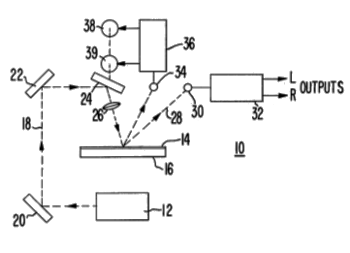
Fig. 1 of US Patent No. 3,992,593, "Disc phonograph record playback by laser generated diffraction pattern," by William K. Heine, November 16, 1976.
(Via Google Patents.)[3)]
By the mid-
20th century,
engineers had the idea that
sound could be recorded on a
magnetic material deposited on a non-magnetic
tape. The
tape recorder was an improvement on earlier
magnetic wire recorders. Tape recorders had much higher fidelity, since the
magnetic domains, the smallest packets of sound
intensity, were the very small
powder particles on the tape, while the domains in the wires were the typical large domains found in bulk materials.
The two major forces in early magnetic sound recording were
Ampex, which produced the recording and playback equipment, and
Minnesota Mining and Manufacturing Company (now, 3M) producing the magnetic tape. The 1947 success of
Bing Crosby in using magnetic tape and
post-production editing technology in
radio broadcasting
created a huge market for tape recording in the radio and recording industries.
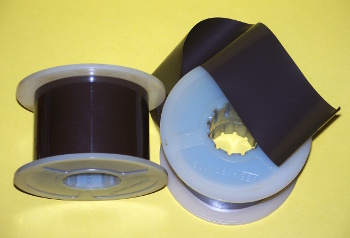
Two-inch wide magnetic tape was used in the SoundScriber, a machine that recorded 24 hours of low-quality audio on a single reel.
(Photo by the author, via Wikimedia Commons.)
Between that time and the advent of
digital audio, just about every sound recording was a tape recording, and just as the movie studios needed to maintain
controlled-environment vaults to archive their films, recoding studios and broadcasters needed similar vaults for their massive piles of audio tape. Safe storage conditions are considered to be 20
°C
and 40%
relative humidity, although one
ISO standard (TR 6371-1989) recommends a lower humidity of 20%.[4]
One interesting magnetic problem associated with archived magnetic tape is "
print-through," in which a faint magnetic image from a layer of tape on a reel is imprinted on an adjacent layer. This is only a problem because of the wide
dynamic range of the
human ear (120 dB, but that covers the range from the
threshold of hearing to experiencing
pain).
Print-through was a minor nuisance, but the recording tape, as a material, was not thought to present any problems. The carrier tape was
mylar, a material with excellent
mechanical properties for tape recording, and the magnetic particles are
ferric oxides (sometimes with additional
elements, such as
chromium) with high
hardness.
What turned out to be the problem was the
polyester-
urethane material used to bind the oxide particles to the mylar. It was a shock to audio engineers when they attempted to play some of their priceless archived recordings and the magnetic layer was plowed off the mylar backing tape by the
playback head. This subsequently named, "sticky-shed syndrome," also fouled the tape recorder mechanism, and that needed to be cleaned before other tapes could be played.
Engineers are inventive, and they eventually found a way to overcome sticky-shed, albeit for the limited time it took to transfer the audio from a sticky-shed tape to fresh media.
baking tapes in a dry
oven at about 120-140
°F for periods up to two days, stopped sticky-shed for a few weeks. The purported reason why baking works is that it drives out some of the
water that reacted with the
polymer binder during years of storage in a humid environment.
This baking technique was transmitted by
social media connections between audio engineers in the early days of the problem. Although it works, heating an important audio tape is not something you would want to do unless it was really necessary; but, how would you know it was necessary, unless the tape does exhibit sticky-shed and is damaged upon playing?
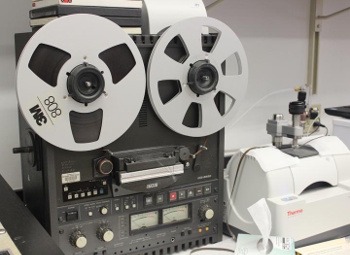
A reel-reel tape recorder and an infrared spectrometer at the University of South Carolina.
(University of South Carolina photograph.)
Chemists at the
University of South Carolina (Columbia, South Carolina) have teamed with an archivist at the
Preservation Research and Testing Division of the
US Library of Congress to investigate a minimally invasive method for differentiating sticky-shed
quarter-inch audio tapes from playable tapes. Their
research is reported in a recent issue of the
American Chemical Society journal,
Analytical Chemistry.[5-6]
There's considerable motivation for such research. The
public policy organization,
Heritage Preservation, estimates that there are more than 46 million archived sound in the
United States alone.[5-6] Since the degradation mechanism appears to be
hydrolysis of the polyester in which water from humid air splits the compound into an
alcohol and a
carboxylic acid.[6] The research team reasoned that such a change should be visible using
infrared spectroscopy.[6]
They used a surface infrared technique,
attenuated total reflectance Fourier-transform infrared spectroscopy, to examine a batch of 133 reel-to-reel audiotapes from the Library of Congress
Motion Picture Broadcasting and Recorded Sound Division. Individual reels from this match had been classified as either playable or sticky-shed by audio engineers. All reels in this lot were probably made by a single manufacturer.[6]
Classification of the infrared spectra was done using
principal component analysis,
quadratic discriminant analysis, and
K-means cluster analysis. Nonplayable tapes had enhanced peak intensities at various
wavenumbers (see figure). such an analysis successfully identified 93.78% of nonplayable tapes in the
calibration set and 92.31% of nonplayable tapes in a subsequent test set.[5]
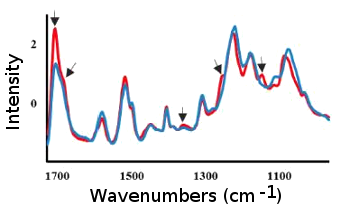
Averaged infrared spectra of 51 playable (blue) and 44 sticky-shed (red) audio tapes.
(University of South Carolina image, adapted from Analytical Chemistry.)
Says
Stephen Morgan, a professor of
chemistry at the University of South Carolina and an author of the research paper,
"This gives archivists a way to triage the tapes that they have... They can identify the ones that can be immediately digitized, and they don't do anything that harms any of them in the process."[6]
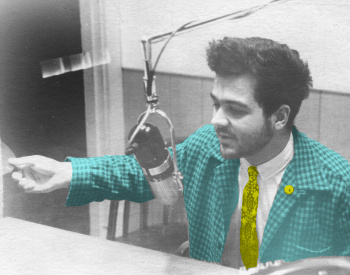
An article on this topic is enough of an excuse to publish this photograph, taken during my college radio days, c. 1967.
(Photo from author's archive, modified using GIMP.)
![]()
References:
- Aristophanes, "The Clouds," F.W. Hall and W.M. Geldart, eds., (Greek text via Project Perseus).
- Aristophanes, "The Clouds," William James Hickie, Trans., Project Gutenberg.
- William K. Heine, "Disc phonograph record playback by laser generated diffraction pattern," US Patent No. 3,992,593, November 16, 1976 (via Google Patents).
- John W.C. Van Bogart, "Magnetic Tape Storage and Handling - A Guide for Libraries and Archives," National Media Laboratory, June 1995, Chap. 5.
- Brianna M. Cassidy, Zhenyu Lu, Nathan C. Fuenffinger, Samantha M. Skelton, Eric J. Bringley, Linhchi Nguyen, Michael L. Myrick, Eric M. Breitung, and Stephen L. Morgan, "Minimally Invasive Identification of Degraded Polyester-Urethane Magnetic Tape Using Attenuated Total Reflection Fourier Transform Infrared Spectroscopy and Multivariate Statistics," Anal. Chem., vol. 87, no. 18 (August 14, 2015), pp, 9265-9272, DOI: 10.1021/acs.analchem.5b01810.
- Steven Powell, "Born to run off the reels," University of South Carolina Press Release, October 14, 2015.
Permanent Link to this article
Linked Keywords: Sound recording and reproduction; audio history; film; soundtrack; machine; mechanical; recording; gramophone record; phonograph record; material; technology; vinyl; hot stamping; metal die; mass production; mass-produce; stylus; tribology; wear; worn; force; archivist; generation; optics; optical; tin; cylinders; laser; opinion; invention; lens; antiquity; burning glass; Aristophanes; The Clouds; Project Perseus; Project Gutenberg; Greek language; Audio Engineering Society; laser turntable; laser-based phonograph; 57th AES convention; Los Angeles; laser diode; semiconductor laser; helium-neon laser; consumer-grade; Finial Technology; dust; dirt; ELP LT-1XA Laser Turntable; digital imaging; signal processing; computer processing; IRENE; Lawrence Berkeley National Laboratory; Google Patents; 20th century; engineer; sound; magnetic material; ribbon; tape; tape recorder; magnetic wire recorder; magnetic domain; intensity; powder; Ampex; 3M; Minnesota Mining and Manufacturing Company; Bing Crosby; post-production editing; radio broadcasting; SoundScriber; Wikimedia Commons; digital audio; controlled-environment vault; Celsius; °C; relative humidity; International Organization for Standardization; ISO standard; print-through; dynamic range; human ear; threshold of hearing; pain; mylar; mechanical properties; ferric oxide; chemical element; chromium; hardness; polyester; polyurethane; urethane; recording head; playback head; baking; oven; Fahrenheit; °F; water; polymer; social media; reel-reel tape recorder; infrared spectroscopy; infrared spectrometer; University of South Carolina (Columbia, South Carolina); Preservation Research and Testing Division; US Library of Congress; quarter-inch audio tape; research; American Chemical Society; Analytical Chemistry; nonprofit organization; public policy organization; Heritage Preservation; United States; hydrolysis; alcohol; carboxylic acid; attenuated total reflectance; Fourier-transform infrared spectroscopy; Motion Picture Broadcasting and Recorded Sound Division; principal component analysis; quadratic discriminant analysis; K-means cluster analysis; wavenumber; calibration; infrared spectra; Stephen Morgan; chemistry; triage; digitizing; digitized; campus radio; college radio; GIMP; William K. Heine, "Disc phonograph record playback by laser generated diffraction pattern," US Patent No. 3,992,593, November 16, 1976.